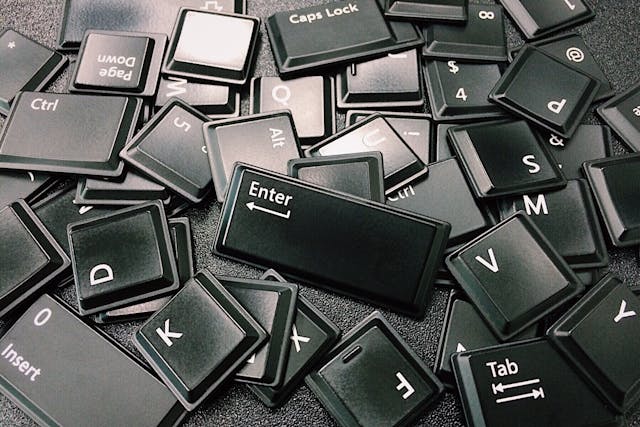10 Proven Strategies to Skyrocket Your Typing Speed
Are you tired of spending what feels like hours typing a simple email or document? Do you envy those lightning-fast typists who effortlessly glide across their keyboards? Well, you’re in luck! In this article, we will unveil 10 proven strategies that will skyrocket your typing speed and make you the master of the keyboard.
Whether you’re a writer, a student, or a professional working in an office, improving your typing speed can significantly boost your productivity. From learning proper finger placement to practicing with online typing test apps, we will cover a wide range of techniques designed to help you increase your words per minute (WPM).
Our step-by-step guide will provide you with actionable tips and exercises that you can implement immediately. Discover the secrets to developing muscle memory, improving accuracy, and eliminating bad typing habits. Soon, you’ll be gliding across the keys effortlessly, saving valuable time and impressing your colleagues and friends.
Understanding the QWERTY Keyboard Layout
Before diving into typing speed test and techniques, it’s essential to familiarize yourself with the QWERTY keyboard layout, which is the most commonly used keyboard design in the world. Named after the first six letters in the top row of the keyboard, this layout was developed to reduce jamming in early typewriters by separating frequently used letter pairings. Understanding the layout is crucial because it forms the basis for your typing speed and accuracy. Familiarity with where each key is located allows for smoother transitions and less mental effort when typing.
The QWERTY layout consists of not only letters but also numbers, symbols, and function keys, each serving specific purposes. It’s vital to recognize the placement of keys beyond the alphabet, including punctuation marks and special characters, as these are integral to composing professional documents and creative writing alike. The more you practice, the more intuitive locating each key will become, allowing your fingers to move fluidly across the keyboard without pausing to think about where each key is.
Additionally, while QWERTY is the most prevalent layout, it’s worth noting that there are alternatives, such as Dvorak and Colemak, designed to optimize typing efficiency further. However, for most people, mastering the QWERTY layout will provide a solid foundation for improving typing speed. Understanding the keyboard is the first step in your journey to becoming a typing expert, so take the time to familiarize yourself with its layout to lay the groundwork for future improvement.

Proper Typing Posture and Hand Positioning
Typing speed is not solely about finger agility; proper posture and hand positioning play a vital role in your overall typing performance. Maintaining an ergonomic posture can help prevent strain and fatigue, allowing for longer and more productive typing sessions. Begin by ensuring that your chair is at the right height so that your feet rest flat on the floor, and your knees are at a 90-degree angle. Your back should be straight, and your shoulders relaxed, with your arms positioned comfortably at your sides.
When it comes to hand positioning, your wrists should be slightly elevated above the keyboard, allowing your fingers to hover naturally over the home row keys (A, S, D, F, J, K, L, and semicolon). This positioning minimizes strain on your wrists and promotes a more fluid typing motion. Avoid resting your wrists on the keyboard or desk while typing, as this can lead to discomfort and potential long-term injuries such as carpal tunnel syndrome. Instead, try using a wrist rest if needed, ensuring that your hands remain in a neutral position while you type.
Lastly, don’t forget about your screen positioning. Your monitor should be at eye level, approximately an arm’s length away, to reduce neck strain and encourage a more relaxed typing posture. Proper ergonomics not only enhances your typing speed but also contributes to your overall comfort and health while working at the computer. By focusing on these aspects, you create a conducive environment for typing practice and improvement, ultimately leading to increased efficiency.
Finger Placement and Typing Techniques
Correct finger placement is crucial for achieving optimal typing speed. Your fingers should always return to the home row keys when not in use. The left hand rests on A, S, D, and F, while the right hand rests on J, K, L, and semicolon. This home row position serves as the anchor for your fingers, allowing you to reach for other keys efficiently without losing your place. As you practice, your fingers will develop muscle memory, making it easier to type without looking at the keyboard.
To enhance your typing technique, it’s essential to utilize all ten fingers instead of relying solely on a few. Each finger has a designated range of keys it should access, ensuring that your hands remain balanced and that you can type at a faster pace. For instance, the left pinky manages the keys Q, A, and Z, while the right pinky handles P, ;, and /. By adhering to these finger assignments, you can significantly reduce the time it takes to reach each key, thereby increasing your overall typing speed.
Additionally, developing a fluid typing rhythm is key to improving your score. Avoid the temptation to rush, as this often leads to mistakes and decreased accuracy. Instead, focus on creating a steady pace that allows for smooth transitions between keys. Practicing with a metronome or typing software that encourages a consistent rhythm can help you build this skill. Over time, as your confidence grows, you will find yourself typing more quickly and accurately, ultimately mastering the art of finger placement and technique.
Learning Touch Typing
Touch typing is an essential skill for anyone looking to enhance their typing speed and accuracy. This method involves typing without having to look at the keyboard, relying instead on the muscle memory developed through practice. Learning touch typing may seem daunting at first, but with consistent effort and the right resources, you can master this technique. Start by familiarizing yourself with the home row keys and gradually progressing to the other keys as you become more comfortable.
One of the key components of touch typing is practicing regularly. Set aside dedicated time each day to focus on this skill, and use online typing courses or software specifically designed for touch typing. Many of these platforms offer structured lessons that guide you through the process, starting with simple exercises and gradually increasing in complexity. As you progress, you will notice a significant improvement in your typing speed and accuracy, which can translate to greater confidence in your writing tasks.
Moreover, incorporating touch typing into your daily routine can help solidify this skill. Whether you are composing emails, writing reports, or chatting with friends, practice typing without looking at the keys. As you gain proficiency, try to challenge yourself by increasing the complexity of the text you are typing. This will not only enhance your skill but also make the learning process more engaging. Ultimately, mastering touch typing will empower you to type with speed and precision, transforming the way you interact with your computer.

Practicing with Typing Exercises and Games
To truly skyrocket your typing speed, regular practice is essential. Engaging in typing exercises tailored to improve both speed and accuracy can yield impressive results. Many typing websites offer a variety of drills that focus on different aspects of typing, from finger placement to speed tests. These exercises often include typing paragraphs, sentences, or even random words, helping to build your familiarity with the keyboard and improve your muscle memory. The more you practice, the more natural the act of typing will become.
Incorporating games into your practice routine can make learning to type much more enjoyable. Typing games turn the process into a fun challenge, allowing you to compete against yourself or others while honing your skills. From fast-paced typing races to word puzzles, these games can be an entertaining way to break the monotony of traditional practice. Many of these games provide instant feedback on your speed and accuracy, allowing you to track your progress and set goals for improvement.
You can also create a practice schedule that includes both structured exercises and game-based learning. For example, dedicate a portion of your day to focused typing drills, and then reward yourself with a typing game. This balanced approach will keep you motivated and engaged while reinforcing the skills you are developing. Over time, you will notice a marked improvement in your typing speed, making your practice sessions not only effective but also enjoyable.
Tips for Improving Typing Speed
Improving your typing speed requires more than just practice; it also involves adopting effective strategies. First and foremost, consistency is key. Set aside dedicated time each day for typing practice, even if it’s just 10 to 15 minutes. The more frequently you practice, the quicker you will see results. Regular practice helps reinforce muscle memory, making it easier to type without looking at the keyboard.
Another essential tip is to focus on accuracy before speed. Many individuals make the mistake of prioritizing speed, which often leads to increased errors and frustration. Instead, concentrate on typing accurately and gradually increase your pace. This approach not only helps build confidence but also reduces the time spent correcting mistakes, ultimately contributing to a higher overall typing speed.
Additionally, consider using a variety of resources to keep your practice sessions fresh and engaging. Experiment with different typing exercises, games, and software to find what resonates with you. Mixing up your routine can prevent boredom and help you maintain motivation. Lastly, remember to take breaks during your practice sessions to avoid fatigue, as mental and physical rest can enhance your performance and retention of skills.

